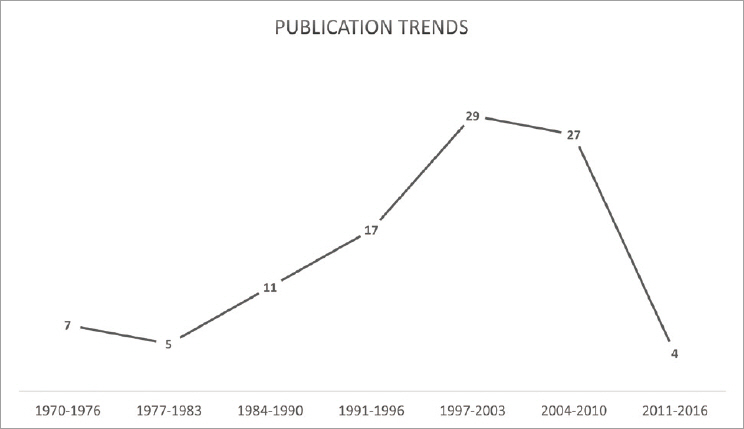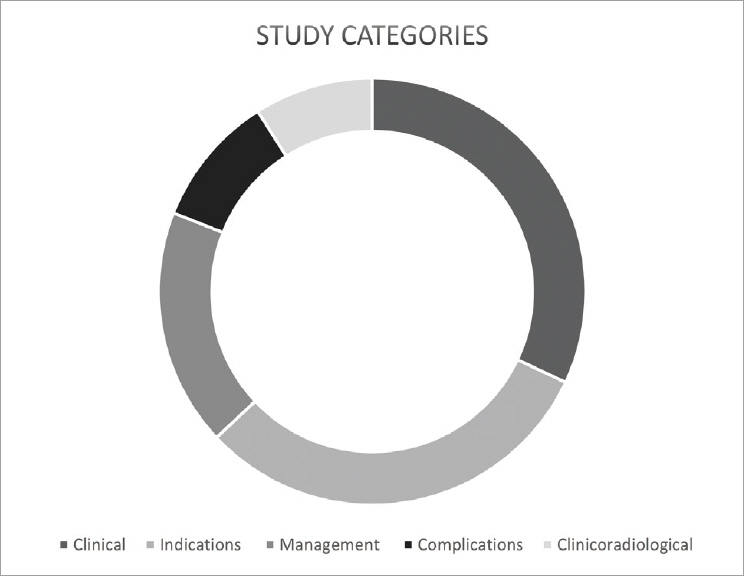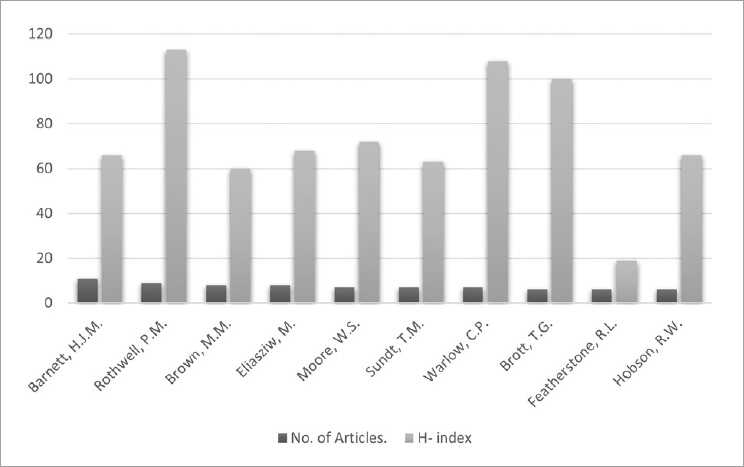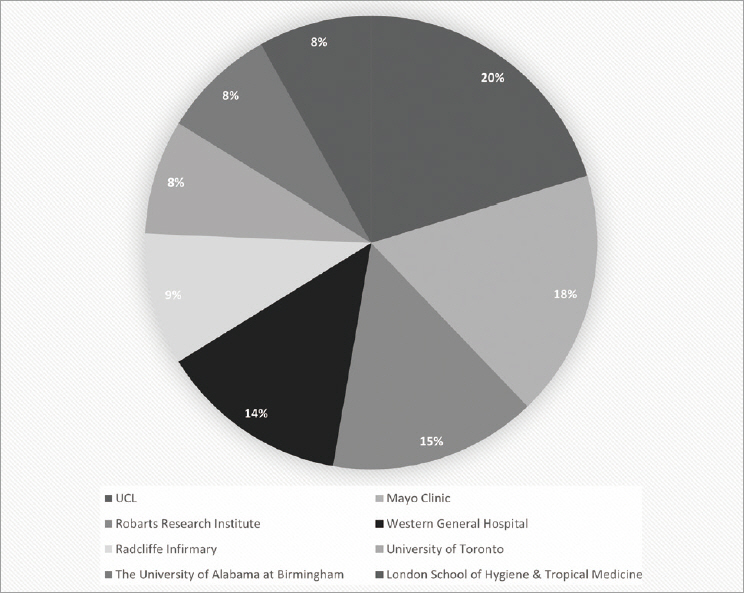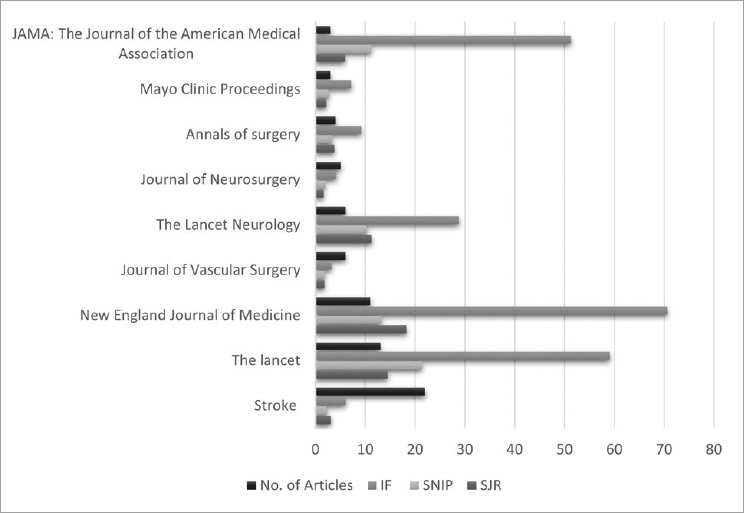J Cerebrovasc Endovasc Neurosurg.
2021 Dec;23(4):314-326. 10.7461/jcen.2021.E2021.03.010.
A bibliometric analysis on the most-cited publications on carotid endarterectomy throughout history
- Affiliations
-
- 1Department of Neurosurgery, Miami University, Miami, USA
- 2Department of Adult Neurosurgery, National Neurosciences Institute, King Fahad Medical City, Riyadh, Saudi Arabia
- KMID: 2523889
- DOI: http://doi.org/10.7461/jcen.2021.E2021.03.010
Abstract
Objective
Carotid endarterectomy (CEA) is the gold standard surgical procedure for managing carotid stenosis due to atherosclerosis and reducing the risk of ischemic stroke. This bibliometric analysis summarizes the most-cited articles on CEA and highlights the contributing articles to today’s evidence-based practice.
Methods
A title-specific search using the Scopus database was used to perform the search. Pertinent article-based, journal-based, and author-based parameters were obtained for review.
Results
A total of 6,824 articles were published between 1970 and 2020. The top 100 most-cited articles accumulated a total of 54,153 citations with an average citation count (CC) of 541, with only a 4.53% self-citation rate for all authors. The publication trends peaked between 1997 and 2010, in which two-third of the highly cited works were published. The most prolific categories with top citations are the clinical, indications, and management, in a descending order. There were 41 published Randomized Controlled Trials (RCT) in the most-cited list.
Conclusions
Citation analysis on carotid endarterectomy has witnessed a marked shift in the publication trends from studying the outcome and complications to comparing carotid stenting with endarterectomy. This analysis is a good introductory article to physicians interested in this topic, as it summarizes the highly impactful articles and enlists the most-cited RCT on CEA.
Keyword
Figure
Reference
-
1. Barnett HJ, Taylor DW, Eliasziw M, Fox AJ, Ferguson GG, Haynes RB, et al. Benefit of carotid endarterectomy in patients with symptomatic moderate or severe stenosis. North American Symptomatic Carotid Endarterectomy Trial Collaborators. N Engl J Med. 1998; Nov. 339:1415–25.2. Bonati LH, Jongen LM, Haller S, Flach HZ, Dobson J, Nederkoorn PJ, et al. New ischaemic brain lesions on MRI after stenting or endarterectomy for symptomatic carotid stenosis: a substudy of the International Carotid Stenting Study (ICSS). Lancet Neurol. 2010; Apr. 9(4):353–62.
Article3. Burak Atci I, Yilmaz H, Samanci MY. The top 50 most-cited articles on low-grade glioma: a bibliometric analysis. Br J Neurosurg. 2019; Apr. 33(2):171–5.
Article4. Chambers BR, Donnan GA. Carotid endarterectomy for asymptomatic carotid stenosis. Cochrane Database Syst Rev. 2005; Oct. 2005(4):CD001923.
Article5. Elarjani T, Almutairi OT, Alhussinan M, Alturkistani A, Alotaibi FS, Bafaquh M, et al. Bibliometric analysis of the top 100 most cited articles on craniosynostosis. Childs Nerv Syst. 2021; Feb. 37(2):587–97.
Article6. Elarjani T, Almutairi OT, Alhussinan M, Alzhrani G, Alotaibi FE, Bafaquh M, et al. Bibliometric Analysis of the Top 100 Most Cited Articles on Cerebral Vasospasm. World Neurosurg. 2021; Jan. 145:e68–82.
Article7. Friedman SG. The first carotid endarterectomy. J Vasc Surg. 2014; Dec. 60:1703–8.
Article8. Gray-Weale AC, Graham JC, Burnett JR, Byrne K, Lusby RJ. Carotid artery atheroma: comparison of preoperative B-mode ultrasound appearance with carotid endarterectomy specimen pathology. J Cardiovasc Surg (Torino). 1988; NovDec. 29(6):676–81.9. Group ECSTC. Randomised trial of endarterectomy for recently symptomatic carotid stenosis: final results of the MRC European Carotid Surgery Trial (ECST). Lancet. 1998; May. 351(9113):1379–87.10. Halliday A, Harrison M, Hayter E, Kong X, Mansfield A, Marro J, et al. 10-year stroke prevention after successful carotid endarterectomy for asymptomatic stenosis (ACST-1): a multicentre randomised trial. Lancet. 2010; Sep. 376(9746):1074–84.
Article11. Moore WS, Barnett HJ, Beebe HG, Bernstein EF, Brener BJ, Brott T, et al. Guidelines for carotid endarterectomy. A multidisciplinary consensus statement from the ad hoc Committee, American Heart Association. Stroke. 1995; Jan. 26(1):188–201.12. v, Barnett HJM, Taylor DW, Haynes RB, Sacket DL, Peerless SJ, et al. Beneficial effect of carotid endarterectomy in symptomatic patients with high-grade carotid stenosis. N Engl J Med. 1991; Aug. 325(7):445–53.
Article13. Ogasawara K, Sakai N, Kuroiwa T, Hosoda K, Iihara K, Toyoda K, et al. Intracranial hemorrhage associated with cerebral hyperperfusion syndrome following carotid endarterectomy and carotid artery stenting: retrospective review of 4494 patients. J Neurosurg. 2007; Dec. 107(6):1130–6.
Article14. Orrapin S, Rerkasem K. Carotid endarterectomy for symptomatic carotid stenosis. Cochrane Database Syst Rev. 2017; Jun. 6(6):CD001081.
Article15. Pritchard A. Statistical bibliography or bibliometrics? Journal of Documentation. 1969; Jan. 25(4):348–9.16. Rothwell PM, Slattery J, Warlow CP. A systematic review of the risks of stroke and death due to endarterectomy for symptomatic carotid stenosis. Stroke. 1996; Feb. 27(2):260–5.
Article17. Samra SK, Dy EA, Welch K, Dorje P, Zelenock GB, Stanley JC. Evaluation of a cerebral oximeter as a monitor of cerebral ischemia during carotid endarterectomy. Anesthesiology. 2000; Oct. 93(4):964–70.
Article18. Spencer MP, Thomas GI, Nicholls SC, Sauvage LR. Detection of middle cerebral artery emboli during carotid endarterectomy using transcranial Doppler ultrasonography. Stroke. 1990; Mar. 21(3):415–23.
Article19. Sundt TM Jr, Sharbrough FW, Piepgras DG, Kearns TP, Messick JM Jr, O’Fallon WM. Correlation of cerebral blood flow and electroencephalographic changes during carotid endarterectomy: with results of surgery and hemodynamics of cerebral ischemia. Mayo Clin Proc. 1981; Sep. 56(9):533–43.
Article20. Taylor DW, Barnett HJ, Haynes RB, Ferguson GG, Sackett DL, Thorpe KE, et al. Low-dose and high-dose acetylsalicylic acid for patients undergoing carotid endarterectomy: a randomised controlled trial. ASA and Carotid Endarterectomy (ACE) Trial Collaborators. Lancet. 1999; Jun. 353(9171):2179–84.21. Walker MD, Marler JR, Goldstein M, Grady PA, Toole JF, Baker WH, et al. Endarterectomy for asymptomatic carotid artery stenosis. Executive Committee for the Asymptomatic Carotid Atherosclerosis Study. JAMA. 1995; May. 273(18):1421–8.22. Wennberg DE, Lucas FL, Birkmeyer JD, Bredenberg CE, Fisher ES. Variation in carotid endarterectomy mortality in the Medicare population: trial hospitals, volume, and patient characteristics. JAMA. 1998; Apr. 279(16):1278–81.
Article23. Yadav JS, Wholey MH, Kuntz RE, Fayad P, Katzen BT, Mishkel GJ, et al. Protected carotid-artery stenting versus endarterectomy in high-risk patients. N Engl J Med. 2004; Oct. 351:1493–501.
Article
- Full Text Links
- Actions
-
Cited
- CITED
-
- Close
- Share
- Similar articles
-
- Recurrent Carotid Artery Stenosis
- A Bibliometric Analysis of Publications on COVID-19 and Older Adults
- Is Carotid Stenting a Reasonable Alternative to Carotid Endarterectomy?
- The most influential articles on kidney transplantation: a bibliometric and visualized analysis
- Microsurgical Endarterectomy for Symptomatic Carotid Artery Stenosis

